Islam in Turkey
 From Wikipedia - Reading time: 31 min
From Wikipedia - Reading time: 31 min
Religion in Turkey  |
|---|
| Secularism in Turkey |
| Irreligion in Turkey |
| Islam by country |
|---|
 |
|
|
Islam is the most practiced religion in Turkey. Most Turkish Sunni Muslims belong to the Hanafi school of jurisprudence. The established presence of Islam in the region that now constitutes modern Turkey dates back to the later half of the 11th century, when the Seljuks started expanding into eastern Anatolia.[2]
While records count the number of Muslims as 99.8%,[I] this is likely to be an overestimation; most surveys estimate lower numbers at around 94%.[3][4][5][6][7] The most popular school of thought (maddhab) being the Hanafi school of Sunni Islam (about 90% of overall Muslim denominations). The remaining Muslim sects, forming about 9% of the Muslim population,[8] consist of Alevis, Ja'faris (representing 1%[9][10]) and Alawites (with an estimated population of around 500,000 to 1 million, or about 1%[11][12]). There is also a minority of Sufi and non-denominational Muslims.[10][13][14][15]
History
[edit]Islamic empires
[edit]
During the Muslim conquests of the 7th and early 8th centuries, Arab armies established the Islamic Empire. The Umayyad Caliphate continued the spread of Islam. The Islamic Golden Age was soon inaugurated by the middle of the 8th century by the ascension of the Abbasid Caliphate and the transfer of the capital from Damascus to Baghdad.[16]
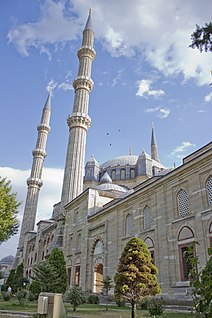
The later period saw initial expansion and the capture of Crete (840). The Abbasids soon shifted their attention towards the East. During the later fragmentation of the Abbasid rule and the rise of their Shiite rivals the Fatimids and Buyids, a resurgent Byzantium recaptured Crete and Cilicia in 961, Cyprus in 965, and pushed into the Levant by 975. The Byzantines successfully contested with the Fatimids for influence in the region until the arrival of the Seljuk Turks who first allied with the Abbasids and then ruled as the de facto rulers.
In 1068, Alp Arslan and allied Turkoman tribes recaptured many Abbasid lands and even invaded Byzantine regions, pushing further into eastern and central Anatolia after a major victory at the Battle of Manzikert in 1071. The disintegration of the Seljuk dynasty resulted in the rise of subsequent, smaller, rival Turkic kingdoms such as the Danishmends, the Sultanate of Rum, and various Atabegs who contested the control of the region during the Crusades and incrementally expanded across Anatolia until the rise of the Ottoman Empire.
Ottoman Caliphate
[edit]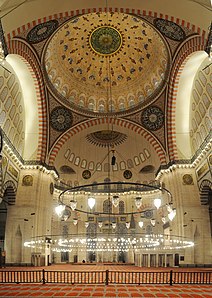
Beginning in the 12th century, new waves of Turkic migrants arrived, many of whom belonging to Sufi orders. Some of these migrants later went on to incorporate heterodox beliefs. One Sufi order that appealed to Turks in Anatolia was the Safaviyya, an order that was originally Sunni and non-political, but later became both Shi'a and politically based in northwest Iran. During the 14th and 15th centuries, the Safavid and similar orders such as the Bektaşi became rivals of the Ottomans—who were orthodox Sunni Muslims—for political control of eastern Anatolia. Although the Bektaşi order became accepted as a sect of orthodox Sunni Muslims, they did not abandon their heterodox beliefs. In contrast, the Safavids eventually conquered Iran, spread their beliefs, and became proponents of orthodox Twelver Shi'a Islam.
The conquest of the Byzantine capital of Constantinople (modern day Istanbul) in 1453 enabled the Ottomans to consolidate their empire in Anatolia and Thrace. The Ottomans later revived the title of caliph during the reign of Selim I. Despite the absence of a formal institutional structure, Sunni religious functionaries continued to play an important political role. In theory, the codified system of sharia regulated all aspects of everyday life, at least for Muslim subjects of the empire. The head of the judiciary ranked directly below the sultan, and was second in power only to the grand vizier. Early in the Ottoman period, the office of grand mufti of Istanbul evolved into that of Şeyhülislam (shaykh, or "leader of Islam"), which had ultimate jurisdiction over all the courts in the empire and consequently exercised authority over the interpretation and application of sharia. Legal opinions pronounced by the Şeyhülislam were considered definitive interpretations.
Secularization era
[edit]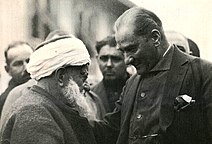
The secularization of Turkey started during the last years of the Ottoman Empire and was a prominent feature of Atatürk's reforms. Under his leadership, the caliphate was abolished, and the secular power of religious authorities and functionaries was reduced and eventually eliminated. Religious foundations were nationalized. The influential and popular orders of the dervish brotherhoods (Tariqa) were also suppressed.
Republic period: 1923–present
[edit]The withdrawal of Turkey, heir to the Ottoman Empire, as the presumptive leader of the international Muslim community, was symbolic of the change in the government's relationship to Islam. Secularism (or laiklik) became one of the "Six Arrows" of Atatürk's program for remaking Turkey. Whereas Islam had formed the identity of Muslims within the Ottoman Empire, secularism was seen as molding the new Turkish nation and its citizens.

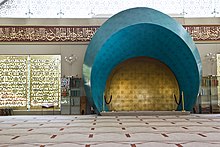
Atatürk's Reforms
[edit]In 1922, the new nationalist regime abolished the Ottoman sultanate, as well as the caliphate in 1924 - the religious office that Ottoman sultans had held for four centuries. Thus, for the first time in Islamic history, no ruler claimed spiritual leadership of Islam.
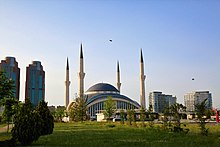
Atatürk and his associates abolished certain religious practices and institutions and generally questioned the value of religion, preferring to place their trust in science. They regarded organized religion as an anachronism and contrasted it unfavorably with "civilization", which to them meant a rationalist, secular culture. Unlike in the West, the establishment of secularism in Turkey was not a gradual process of separation of church and state. In the Ottoman Empire, all residents, at least theoretically, had been subject to traditional religious law, and Sunni religious organizations had been part of the state structure. However, the state usually had authority over the clergy and religious law (e.g. many Sultans are known to change Şeyhülislams, who do not approve of state politics). When the reformers of the early 1920s opted for a secular state, they removed religion from the sphere of public policy and restricted it to exclusively that of personal morals, behavior, and faith. Although private observance of religious rituals could continue, religion and religious organization were excluded from public life.
In addition to the abolition of the caliphate, new laws mandated the abolition of the office of Şeyhülislam and the religious hierarchy, the closing and confiscation of Sufi lodges, meeting places, and monasteries and the outlawing of their rituals and meetings, the establishment of government control over vakıfs which had been inalienable under Sharia, the replacement of sharia with adapted European legal codes; the closing of religious schools; the abandonment of the Islamic calendar in favor of the Gregorian calendar used in the West, and restrictions on public attire that had religious associations, with the fez outlawed for men and the veil discouraged for women.
Atatürk and his colleagues also attempted to "turkify" Islam through official encouragement of practices such as the usage of Turkish rather than Arabic at devotions, substituting the Turkish word Tanrı for the Arabic word Allah, and incorporating Turkish into daily calls to prayer. These changes in devotional practices caused widespread criticism among Muslims, which led to a return to the Arabic version of the call to prayer in 1950, after the opposition party DP won the elections. Of longer-lasting effect were the regime's measures of prohibiting religious education, restricting the building of new mosques, and transferring existing mosques to secular purposes - most notably the Hagia Sophia (Justinian's sixth-century Christian basilica, which had been converted into a mosque by Mehmet II), which was turned into a museum in 1935. Muftis and imams were appointed by the government, and religious instruction was taken over by the Ministry of National Education. As a result of these policies, the Turkish Republic was judged negatively by some sections of the Muslim world.
The common expectation was that these policies of the 1920s and 1930s would diminish the role of religion in public, which, however, did not occur. As early as 1925, religious grievances were one of the principal causes of the Şeyh Sait rebellion, an uprising in southeastern Turkey that may have claimed as many as 30,000 lives before being suppressed.
Although Turkey was secularized at a legal level, religion remained a strong force. After 1950, some political leaders espoused support for programs and policies that appealed to the religiously inclined in an attempt to benefit from a lot of the population's attachment to religion. Such efforts were opposed by most of the state, who believed that secularism was an essential principle of Kemalist Ideology. This gradually led to a polarization of the entire country, which became especially evident in the 1980s, as a new generation of religiously motivated local leaders emerged to challenge the dominance of the secularized political elite.
By 1994, slogans promising that a return to Islam would cure economic ills and solve the problems of bureaucratic inefficiencies had enough general appeal to enable avowed religious candidates to win mayoral elections in Istanbul and Ankara.
Multi-party period
[edit]Following the loosening of authoritarian political control in 1946, a large number of people began to openly call for a return to traditional religious practices. During the 1950s, even certain political leaders found it expedient to join religious leaders in advocating more state respect for religion.[18]
A more direct manifestation of the growing reaction against secularism was the revival of the Sufi brotherhoods. Not only did suppressed Sufi orders such as the Kadiri, Mevlevi, Nakşibendi, Khālidiyyā and Al-Ṭarīqah al-Tijāniyyah reemerge, but new movements were formed, including the Nur Cemaati, Gülen movement, Sülaymānīyyā, Community of İskenderpaşa and İsmailağa. The Tijāni became especially militant in confronting the state, damaging monuments to Atatürk to symbolize their opposition to his policy of secularization. This was, however, an isolated incident and only involved one particular Sheikh of the order. Throughout the 1950s, there were numerous trials of Ticani and other Sufi leaders for anti-state activities.
Simultaneously, some movements, notably the Süleymancı and Nurcular, cooperated with those politicians perceived as supportive of pro-Islamic policies. The Nurcular eventually advocated support for Turkey's multi-party political system, and one of its offshoots, the Gülen movement, had supported the True Path Party while the Işıkçılar and Enver Ören had openly supported the Motherland Party since the mid-1980s.
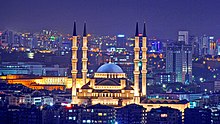
The demand for restoration of religious education in public schools began in the late 1940s. The government initially responded by authorizing religious instruction in state schools for those students whose parents requested it. Under the rule of the Democrat Party during the 1950s, religious education was made compulsory in secondary schools unless parents made a specific request to have their children excused. Religious education was made compulsory for all primary and secondary school children in 1982.
The reintroduction of religion into the school curriculum raised the question of religious higher education. The seculars believed that Islam could be "reformed" if future leaders were trained in state-controlled seminaries. To further this goal, the government in 1949 established a faculty of divinity at Ankara University to train teachers of Islam and imams. In 1951 the Democrat Party government set up special secondary schools (İmam Hatip schools) for the training of imams and preachers. The number of these schools expanded rapidly to over 250 during the 1970s, when the pro-Islam National Salvation Party participated in coalition governments. Following the 1980 coup, the military, although secular in orientation, viewed religion as an effective means to counter socialist ideas and thus authorized the construction of 90 more İmam Hatip high schools.
During the 1970s and 1980s, Islam experienced political rehabilitation due to center-right secular leaders perceiving religion as a potential bulwark in their ideological struggle with center-left secular leaders. A small advocacy group that became extremely influential was the Intellectuals' Hearth (Turkish: Aydınlar Ocağı), an organization that holds the beliefs that true Turkish culture is a synthesis of the Turks' pre-Islamic traditions and Islam. According to the Hearth, Islam not only constitutes an essential aspect of Turkish culture, but is a force that can be regulated by the state to help socialize the people to be obedient citizens acquiescent to the overall secular order. After the 1980 coup, many of the Hearth's proposals for restructuring schools, colleges, and state broadcasting were adopted. The result was a purge from these state institutions of more than 2,000 intellectuals perceived as espousing leftist ideas incompatible with the Hearth's vision of Turkey's national culture.

The state's more tolerant attitude toward Islam encouraged the proliferation of private religious activities, including the construction of new mosques and Qur'an schools in the cities, the establishment of Islamic centers for research on and conferences about Islam and its role in Turkey, and the establishment of religiously oriented professional and women's journals. The printing of newspapers, the publication of religious books, and the growth of innumerable religious projects ranging from health centers, child-care facilities, and youth hostels to financial institutions and consumer cooperatives flourished. When the government legalized private broadcasting after 1990, several Islamic radio stations were organized. In the summer of 1994, the first Islamic television station, Kanal 7, began broadcasting, first in Istanbul and then in Ankara.
Although the tarikah have played a seminal role in Turkey's religious revival and in the mid-1990s still published, several of the country's most widely circulated religious journals and newspapers, a new phenomenon, İslamcı Aydın (the Islamist intellectual), unaffiliated with the traditional Sufi orders, emerged during the 1980s. Prolific and popular writers such as Ali Bulaç, Rasim Özdenören, and İsmet Özel drew upon their knowledge of Western philosophy, Marxist sociology, and radical Islamist political theory to advocate for a modern Islamic perspective that does not hesitate to criticize societal issues while simultaneously remaining faithful to the ethical values and spiritual dimensions of religion. Islamist intellectuals are harshly critical of Turkey's secular intellectuals, whom they fault for trying to do in Turkey what Western intellectuals did in Europe: substitute worldly materialism, in its capitalist or socialist version, for religious values.
On 15 July 2016, a coup d'état was attempted in Turkey against state institutions by a faction within the Turkish Armed Forces with connections to the Gülen movement, citing an erosion in secularism.
Diyanet and secularism
[edit]
There is an administration called "Presidency of Religious Affairs" or Diyanet[19] manages 77,500 mosques. This state agency, established by Atatürk (1924), finance only Sunni Muslim worship Other religions must ensure a financially self-sustaining running and they face administrative obstacles during operation.[20]
| Religions | Estimated population | Expropriation measures[21] |
Official recognition through the Constitution or international treaties | Government Financing of places of worship and religious staff |
|---|---|---|---|---|
| Sunni Islam - Hanafi & Shafi'i | more than 85%[22][23] | No | Yes through the Diyanet mentioned in the Constitution (art.136)[24] | Yes through the Diyanet[25] |
| Shia Islam - Alevi[26] | less than %5 to more than 30%[27][22][28] | Yes[29] | No.[30] In the early fifteenth century,[31] due to the unsustainable Ottoman oppression, Alevis supported Shah Ismail I who had Turkmen origins. Shah Ismail I supporters, who wear a red cap with twelvefolds in reference to the 12 Imams were called Qizilbash. Ottomans considered the Qizilbash (Alevi) as appendages of Safavid Empire. Today, Cemevi, places of worship of Alevi-Bektashi have no official recognition. | No[25] |
| Shia Islam - Bektashi[26] | No.[30] In 1826 with the abolition of the Janissary corps, the Bektashi tekke (dervish convent) were closed.[29][32] | |||
| Shia Islam - Ja'fari | ~1% |
No[30] | No[25] | |
| Shia Islam - Alawites[26] | ~1%[33] | No[30] | No[25] | |
| Ghair Muqallid and Quranist Muslim | ~2% [10] | - | - | - |
The Diyanet is an official state institution established in 1924 and works to provide Quranic education for children, as well as drafting weekly sermons delivered to approximately 85,000 different mosques. Furthermore, the Diyanet employs all of the imams in Turkey.[34]
When collecting tax, all Turkish citizens are equal. The tax rate is not based on religion. However, through the Diyanet, Turkish citizens are not equal in the use of revenue. The Presidency of Religious Affairs, which has a budget over U.S. $2.5 billion in 2012, finance only Sunni Muslim worship.[35]
Sufi orders like Alevi-Bektashi, Bayrami-Jelveti, Halveti (Gulshani, Jerrahi, Nasuhi, Rahmani, Sunbuli, Ussaki), Hurufi-Rüfai, Malamati, Mevlevi, Nakşibendi (Halidi, Haqqani), Qadiri-Galibi and Ja'fari Muslims[29] are not officially recognized.
| Part of a series on Sunni Islam |
|---|
 |
|
|
Headscarf issue
[edit]| Do you cover when going outside?[36] | ||
|---|---|---|
| 2011 | 2021 | |
| No, I do not | 37% | 41% |
| Yes, I wear a headscarf | 53% | 48% |
| Yes, I wear a türban | 9% | 10% |
| Yes, I wear a çarşaf | 1% | 1% |
Although intellectual debates on the role of Islam attracted widespread interest, they did not provoke the kind of controversy that erupted over the issue of appropriate attire for Muslim women. During the early 1980s, female college students who were determined to demonstrate their commitment to Islam began to cover their heads and necks with scarves and wear long, shape-concealing overcoats. The appearance of these women in the citadels of Turkish secularism shocked those men and women who tended to perceive such attire as a symbol of the Islamic traditionalism they rejected. Militant secularists persuaded the Higher Education Council to issue a regulation in 1987 forbidding female university students to cover their heads in class. Protests by thousands of religious students and some university professors forced several universities to waive enforcement of the dress code. The issue continued to be seriously divisive in the mid-1990s. Throughout the first half of the 1990s, highly educated, articulate but religiously pious women have appeared in public dressed in Islamic attire that conceals all but their faces and hands. Other women, especially in Ankara, Istanbul, and İzmir, have demonstrated against such attire by wearing revealing fashions and Atatürk badges. The issue is discussed and debated in almost every type of forum – artistic, commercial, cultural, economic, political, and religious. For many citizens of Turkey, women's dress has become the issue that defines whether a Muslim is secularist or religious. In 2010, the Turkish Higher Educational council (YÖK) lifted the ban on headscarves at the universities. Since the start of his presidency, President Recep Tayyip Erdogan has drastically increased the amount of religious high schools across Turkey to support his plan on bringing up a more pious generation. However, this push on piousness in school children seems to have had an adverse effect, for there is anecdotal evidence of a notable number of Turkish students from religious high schools admitting their loss of faith in Islamic beliefs, which has caused substantial amount of discussion among politicians and religious clerics.[37]
More recently in 2016, Turkey approved hijab as the part of the official police uniform. For the first time, female officers will be able to cover their heads with a headscarf under their police caps. This act was pushed by President Recep Tayyip Erdogan's Islamist-rooted Justice and Development Party (AKP) that have been pushing for relaxed restrictions on the hijab.
Denominations
[edit]
Sunni Islam
[edit]The vast majority of the present-day Turkish people are Muslim and the Sunni Islam is the most populous Islamic sect, comprising about 90% of the Muslims in the country. The most popular school of law is the Hanafite madh'hab of Sunni Islam. The Hanafi madhhab was the official school of Islamic jurisprudence espoused by the Ottoman Empire[38][39] and a 2013 survey conducted by the Turkish Directorate of Religious Affairs indicates that 77.5% of Turkish Muslims identify themselves as Hanafis.[40] Another common Sunni jurisprudence, Shafi'i is the dominant one in Turkish Kurdistan. Although the Maturidi and Ash'ari schools of Islamic theology (which apply Ilm al-Kalam or rational thought to understand the Quran and the hadith) have been the dominant creeds in Turkey due to their widespread acceptance and propagation since the beginning of the Ottoman Empire,[38] the Athari (literalist) creed[41] of the Salafi movement has seen increasing acceptance.[39]
Compared to the Hanbali school of Islam, the Hanafi school of Islam takes a much more liberal take on the religion, allowing for a more lenient interpretation of religious law.[42]
| Part of a series on Shia Islam |
|---|
 |
|
|

| Part of a series on the Alevis Alevism |
|---|
|
|
Shia Islam
[edit]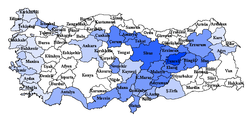
Twelver branch of Shia Islam Muslim population of Turkey is composed of Ja'fari aqidah and fiqh, Batiniyya-Sufism aqidah of Maymūn’al-Qāddāhī fiqh of the Alevīs, and Cillī aqidah of Maymūn ibn Abu’l-Qāsim Sulaiman ibn Ahmad ibn at-Tabarānī fiqh of the Alawites,[43][44] who altogether constitutes nearly one tenth of the whole population of the country. An estimate for the Turkish Alevi population varies from 3.5 million to 11 million.[45][46][36] However it's so hard to estimate a realistic number for Shia population in Turkey since the country doesn't conduct ethnic or religious censuses.
Unlike the common usage of the term "Shi'a" in other languages, Aleviler instead is being frequently used to represent all the Shi'a Muslim sects in Turkish language. Furthermore, the term Kızılbaş in the history was used pejoratively for all Shi'ites in Anatolia.
Alevis
[edit]Estimates for Alevi population vary from less than 4 million to more than 12 million according to different sources.[8][22][27] It's hard to make a realistic estimate for their population since the Turkish government has never asked about religious denominations in conducted censuses. Other reasons for this are the secular tendencies of the Alevi population and oppression by Sunni Islamists, which causes most Alevis to hide their religious identity. However, considering the few conducted reliable surveys, ~10% can be taken as a simplistic estimation.[22][47][28] Some people use the term Alevi to refer all Shia Muslims in Turkey since they are the dominant Shia sect in the country.
- The Alevi ʿaqīdah
- Some of their members (or sub-groups, especially those belonging to Qizilbash and Hurufism) claim that God takes abode in the bodies of the human-beings (ḥulūl), believe in metempsychosis (tanāsukh),[48]
- Some of the Alevis criticize the course of Islam as it is being practiced overwhelmingly by more than 99% of Sunni and Shia population.[49]
- Regular daily salat and fasting in the holy month of Ramadan are not officially done by the Qizilbashs, Hurufis, and Ishikist groups. These members of Yazdânism like Ishikists and Yarsanis who portrayed themselves as Alevis, are frequently denounced by the Dedes.
Ja'faris
[edit]The followers of the Ja'fari jurisprudence constitute the third sizable community. It is historically the primary denomination of ethnic Azerbaijani people. Most of them lives in the eastern provinces neighboring to Azerbaijan, more particularly in the Iğdır Province and Kars Province, but also larger cities in the west. It is estimated that Ja'faris make up 4% of the population of Turkey, i.e. about 3,300,000.[50] They have 70 mosques in Istanbul and some 300 throughout the country and receive no state funding for their mosques and imams as the Presidency of Religious Affairs (Diyanet) is exclusively Sunni.[51]
| Part of a series on Islam Sufism |
|---|
 |
|
|

Alawites
[edit]The majority of the Alawite community in Turkey with an estimated population of around 1 million[52] lives in the Province of Hatay, where they nearly represent half of the total population,[53] primarily in the districts of Arsuz,[54] Defne and Samandağ,[52] where Alawites constitute the majority and in Iskenderun and Antakya where they constitute a significant minority of the population. Larger Alawite communities can also be found in the Çukurova region, mostly in and around the cities of Adana, Tarsus and Mersin.[12] They are known as Arab Alevis by Turkish people.
Sufism
[edit]Folk Islam in Turkey has derived many of its popular practices from Sufism which has good presence in Turkey and Egypt. Particular Sufi shaikhs – and occasionally other individuals reputed to be pious – were regarded after death as saints having special powers. Veneration of saints (both male and female) and pilgrimages to their shrines and graves represent an important aspect of popular Islam in the country. Folk Islam has continued to embrace such practices although the veneration of saints officially has been discouraged since the 1930s. Plaques posted in various sanctuaries forbid the lighting of candles, the offering of votive objects, and related devotional activities in these places. Modern day Sufi shaykhs with large adherents in Turkey include Shaykh Mehmet Efendi[who?] (residing in Istanbul) and Mawlana Sheikh Nazim Al-Haqqani who resided in Lefka, North Cyprus, until his death in May, 2014.
Quranism
[edit]Those who do not accept the authority of hadith, known as Quranists, Quraniyoon, or Ahl al-Quran, are also present in Turkey.[55][56] In Turkey, Quranist ideas became particularly noticeable, with portions of the youth either leaving Islam or converting to Quranism.[57] There has been significant Quranist scholarship in Turkey, with there being even Quranist theology professors in significant universities, including scholars like Yaşar Nuri Öztürk[58] and Caner Taslaman.[59] Some believe that there are secret Quranists even in the Diyanet itself.
The Turkish Directorate of Religious Affairs (Diyanet) regularly criticizes and insults Quranists, gives them no recognition and calls them kafirs (disbelievers).[60]
See also
[edit]- Christianity in Turkey
- Religion in Turkey
- Secularism in Turkey
- Minorities in Turkey
- Islam by country
- Turkish adhan
Notes
[edit]- ^ These are based on the existing religion information written on every citizen's national ID card, automatically passed on from the parents to every newborn, and do not necessarily represent individual choice. Furthermore, anyone who was not officially registered as Christian or Jewish by the time of the foundation of the republic, was automatically recorded as Muslim, and this label has been passed down to new generations. Therefore, the official number of Muslims also includes people with no religion; converted from Islam to a different religion than Islam; and anyone who is of a different religion than their parents but hasn't applied for a change of their individual records.
References
[edit]- ^ "Muslim Population Growth in Europe Pew Research Center". 10 July 2024. Archived from the original on 10 July 2024.
- ^ Aktas, Vahap (1 January 2014). "Islamization of Anatolia and the Effects of Established Sufism (Orders)". The Anthropologist. 17 (1): 147–155. doi:10.1080/09720073.2014.11891424. ISSN 0972-0073. S2CID 55540974. Archived from the original on 22 November 2021. Retrieved 27 October 2020.
- ^ Nişancı, Zübeyir (21 March 2023). Ayşe Betül Aydın; Hatice Nur Keskin (eds.). Faith and Religiosity in Türkiye (PDF). Marmara University. ISBN 978-1-64205-906-9. Archived (PDF) from the original on 20 April 2023. Retrieved 23 August 2023.
- ^ "WVS Database".
- ^ Çiçek, Nevzat (26 March 2023). ""Türkiye'de İnanç ve Dindarlık" araştırması yayımlandı: Dindarlaştık mı, sekülerleştik mi?" ["Faith and Religiosity in Turkey" research was published: Have we become religious or secularized?] (in Turkish). indyturk.com.
- ^ "Country – Turkey". Joshua Project. Archived from the original on 20 March 2016. Retrieved 27 April 2014.
- ^ "Optimar'dan din-inanç anketi: Yüzde 89 Allah'ın varlığına ve birliğine inanıyor". T24 (in Turkish). Archived from the original on 29 March 2020. Retrieved 21 May 2023.
- ^ a b "Turkey: International Religious Freedom Report 2007". U.S. Department of State. Archived from the original on 4 December 2019. Retrieved 22 September 2016.
- ^ "Shi'a". Archived from the original on 10 January 2011. Retrieved 12 August 2009.
- ^ a b c "Pew Forum on Religious & Public life". pewforum.org. 9 August 2012. Archived from the original on 26 December 2016. Retrieved 29 October 2013.
- ^ "Syria strife tests Turkish Alawites | Turkey | al Jazeera". Archived from the original on 1 October 2018. Retrieved 10 June 2016.
- ^ a b Prochazka-Eisl, Gisela. "The Arabic speaking Alawis of the Çukurova: The transformation of a linguistic into a purely religious minority". Christiane Bulut: Linguistic Minorities in Turkey and Turkic-Speaking Minorities of the Peripheries, Harrassowitz (Wiesbaden) Forthcoming. Archived from the original on 22 November 2021. Retrieved 6 April 2018.
- ^ "Sufism". All about Turkey. 20 November 2006. Archived from the original on 8 June 2008. Retrieved 1 November 2010.
- ^ ÖZKÖK, Ertuğrul (21 May 2019). "Türkiye artık yüzde 99'u müslüman olan ülke değil". www.hurriyet.com.tr (in Turkish). Archived from the original on 23 May 2019. Retrieved 13 August 2020.
- ^ "Optimar'dan din-inanç anketi: Yüzde 89 Allah'ın varlığına ve birliğine inanıyor". T24.com.tr. Archived from the original on 29 March 2020. Retrieved 4 April 2020.
- ^ Gregorian, Vartan. Islam: A Mosaic, Not a Monolith, Brookings Institution Press, 2003, pp. 26–38 ISBN 0-8157-3283-X
- ^ Strickland, Carol (3 August 2009). "Mosque modern". Christian Science Monitor. Archived from the original on 19 November 2020. Retrieved 23 September 2020.
- ^ Öztürk, Ahmet Erdi (26 February 2019). "An alternative reading of religion and authoritarianism: the new logic between religion and state in the AKP's New Turkey" (PDF). Southeast European and Black Sea Studies. 19: 79–98. doi:10.1080/14683857.2019.1576370. ISSN 1468-3857. S2CID 159047564. Archived (PDF) from the original on 22 November 2020. Retrieved 4 June 2020.
- ^ "T.C. Diyanet İşleri Başkanlığı | İman | İbadet | Namaz | Ahlak". Archived from the original on 25 October 2015. Retrieved 22 November 2021.
- ^ Ahmet Erdi Öztürk (2016). "Turkey's Diyanet under AKP rule: from protector to imposer of state ideology?" (PDF). Southeast European and Black Sea Studies. 16 (4): 619–635. doi:10.1080/14683857.2016.1233663. S2CID 151448076. Archived (PDF) from the original on 6 May 2020. Retrieved 4 June 2020.
- ^ "Le gouvernement turc va restituer des biens saisis à des minorités religieuses". La Croix. 29 August 2011. Archived from the original on 7 October 2017. Retrieved 23 February 2017 – via www.la-croix.com.
- ^ a b c d "TR100". interaktif.konda.com.tr. Archived from the original on 25 June 2022. Retrieved 14 August 2022.
- ^ "Mapping the Global Muslim Population". Pew Research Center's Religion & Public Life Project. 7 October 2009. Archived from the original on 14 June 2022. Retrieved 17 August 2022.
- ^ "Türki̇ye Büyük Mi̇llet Mecli̇si̇" (PDF). Archived (PDF) from the original on 8 December 2014. Retrieved 8 March 2013.
- ^ a b c d "Cahiers de L'obtic" (PDF). Observatoire de recherche interdisciplinaire sur la Turquie contemporaine. December 2012. Archived from the original (PDF) on 2 October 2013. Retrieved 8 March 2013.
- ^ a b c Not recognized as an Islamic fiqh madh'hab by the Amman Message.
- ^ a b "Cem Vakfı Başkanı İzzettin Doğan: Alevilerin oylarını verdiği kişi Mustafa Kemal Atatürk'tür | Independent Türkçe". 15 April 2021. Archived from the original on 15 April 2021. Retrieved 14 August 2022.
- ^ a b "Mapping the Global Muslim Population". Pew Research Center's Religion & Public Life Project. 7 October 2009. Archived from the original on 14 June 2022. Retrieved 14 August 2022.
- ^ a b c The World of the Alevis: Issues of Culture and Identity, Gloria L. Clarke
- ^ a b c d Lisa Deheurles-Montmayeur (2010). "Les minorités non musulmanes en Turquie : "certains rapports d'ONG parlent d'une logique d'attrition", observe Jean-Paul Burdy". doi:10.58079/smk9. Archived from the original on 28 November 2017. Retrieved 23 February 2017.
- ^ Bacqué-Grammont, Jean-Louis (1979). "Notes et documents sur les Ottomans, les Safavides et la Géorgie, 1516-1521". Cahiers du Monde Russe et Soviétique. 20 (2): 239–272. doi:10.3406/cmr.1979.1359.
- ^ "Blog Hautetfort : Erreur 404". Archived from the original on 3 March 2016. Retrieved 23 February 2017.
- ^ Spencer, Richard (3 April 2016). "Who are the Alawites?". The Telegraph. ISSN 0307-1235. Archived from the original on 10 October 2022. Retrieved 14 August 2022.
- ^ "CSIA". Archived from the original on 22 December 2019. Retrieved 11 November 2019.
- ^ Sözeri, Semiha; Öztürk, Ahmet Erdi (September 2018). "Diyanet as a Turkish Foreign Policy Tool: Evidence from the Netherlands and Bulgaria" (PDF). Politics and Religion. 11 (3): 624–648. doi:10.1017/S175504831700075X. ISSN 1755-0483. S2CID 148657630. Archived (PDF) from the original on 6 May 2020. Retrieved 4 June 2020.
- ^ a b "TR100". interaktif.konda.com.tr. Archived from the original on 25 June 2022. Retrieved 11 August 2022.
- ^ Girit, Selin (10 May 2018). "Losing their religion: The young Turks rejecting Islam". Archived from the original on 3 April 2019. Retrieved 10 November 2019.
- ^ a b McLean, George F. (1996). Normative Ethics and Objective Reason. CRVP. ISBN 978-1-56518-022-2. Archived from the original on 24 August 2021. Retrieved 20 August 2015.
- ^ a b "Salafism Infiltrates Turkish Religious Discourse". Middle East Institute. Archived from the original on 11 September 2021. Retrieved 22 November 2021.
- ^ Aydoğan Vatandaş, "Can Turkey be ISIL's next stage", Today's Zaman Archived 2015-10-25 at the Wayback Machine October 16, 2015
- ^ Halverson, Theology and Creed in Sunni Islam, 2010: 38–48
- ^ Tol, Gonul (10 January 2019). "Turkey's Bid for Religious Leadership". Foreign Affairs: America and the World. ISSN 0015-7120. Archived from the original on 10 November 2019. Retrieved 10 November 2019.
- ^ "Muhammad ibn Āliyy’ūl Cillī aqidah" of "Maymūn ibn Abu’l-Qāsim Sulaiman ibn Ahmad ibn at-Tabarānī fiqh" (Sūlaiman Affandy, Al-Bākūrat’ūs Sūlaiman’īyyah - Family tree of the Nusayri Tariqat, pp. 14–15, Beirut, 1873.)
- ^ Both Muhammad ibn Āliyy’ūl Cillī and Maymūn ibn Abu’l-Qāsim’at-Tabarānī were the murids of "Al-Khaṣībī", the founder of the Nusayri tariqa.
- ^ "Religions". CIA World Factbook. Archived from the original on 20 December 2018. Retrieved 9 July 2016.
- ^ "Mapping the Global Muslim Population". Pew Research Center. 7 October 2009. Archived from the original on 25 December 2018. Retrieved 9 July 2016.
- ^ Seskir, Zeki (24 June 2020). ""Türkiye'de 40 milyon Kürt 25 milyon Alevi olması" ya da "Türkiye Türklerindir"". Medium.
- ^ Halm, Heinz (21 July 2004). Shi'ism. Edinburgh University Press. p. 154. ISBN 978-0-7486-1888-0.
- ^ Yaşar Nuri Öztürk, Kur'an'daki İslam.
- ^ "2022 Report on International Religious Freedom: Turkey (Türkiye)". United States Department of State. Retrieved 29 January 2024.
- ^ "Turkish Shiites fear growing hate crimes - Al-Monitor: The Pulse of the Middle East". www.al-monitor.com. 11 July 2014. Archived from the original on 22 November 2021. Retrieved 22 November 2021.
- ^ a b Cassel, Matthew. "Syria strife tests Turkish Alawites". Archived from the original on 1 October 2018. Retrieved 23 February 2017.
- ^ Sotloff, Steven (10 September 2012). "The Alawite Towns That Support Syria's Assad — in Turkey". Time. Archived from the original on 11 November 2018. Retrieved 23 February 2017 – via world.time.com.
- ^ simitincilicia (30 September 2012). "A Weekend in Arsuz". Archived from the original on 7 February 2017. Retrieved 23 February 2017.
- ^ Aisha Y. Musa, The Qur'anists Archived 2013-07-19 at the Wayback Machine, 19.org, Retrieved 6 July 2013.
- ^ "Turkish News - Latest News from Turkey". Hürriyet Daily News. Archived from the original on 16 July 2009. Retrieved 22 November 2021.
- ^ Öztürk: Modern Döneme Özgü Bir Kur’an Tasavvuru. 2010, S. 24.
- ^ Mustafa Akyol, Islam without Extremes: A Muslim Case for Liberty, W.W. Norton & Company, 2011, p. 234
- ^ "Associates and Affiliates". 19.org. Archived from the original on 12 July 2013. Retrieved 14 July 2013.
- ^ Patheos.com: „Quran, Hadiths or Both? Where Quranists and Traditional Islam Differ.“ [21.1.2020].
Further reading
[edit]- Bein, Amit. Ottoman Ulema, Turkish Republic: Agents of Change and Guardians of Tradition (2011) Amazon.com
- Karakas, Cemal (2007) "Turkey. Islam and Laicism Between the Interests of State, Politics and Society". Peace Research Institute Frankfurt (PRIF), Germany, PRIF-Report No. 78/2007.
- Smith, Thomas W. (2005) "Between Allah and Ataturk: Liberal Islam in Turkey", The International Journal of Human Rights, Vol. 9, No. 3., pp. 307–325.
- Yavuz, M. Hakan. Islamic Political Identity in Turkey (2003) Amazon.com
- Chopra, R.M., Sufism, 2016, Anuradha Prakashan, New Delhi. ISBN 978-93-85083-52-5.
- Yavuz, M. Hakan and Öztürk, Ahmet Erdi (2019), "Turkish Secularism and Islam Under the Reign of Erdoğan", Southeast and Black Sea Studies, Vol. 19, NO. 1; https://doi.org/10.1080/14683857.2019.1580828
 KSF
KSF


